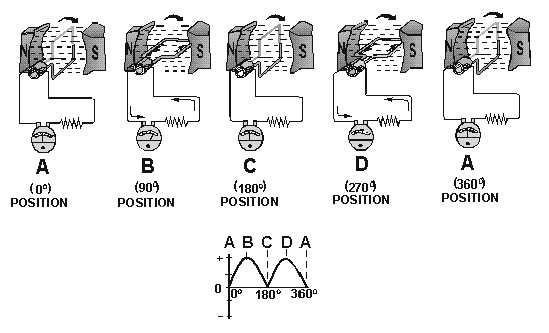1-5
Figure 1-4.—Effects of commutation.
For the remainder of this discussion, refer to figure 1-4, parts A through D. This will help you in
following the step-by-step description of the operation of a dc generator. When the armature loop rotates
clockwise from position A to position B, a voltage is induced in the armature loop which causes a current
in a direction that deflects the meter to the right. Current flows through loop, out of the negative brush,
through the meter and the load, and back through the positive brush to the loop. Voltage reaches its
maximum value at point B on the graph for reasons explained earlier. The generated voltage and the
current fall to zero at position C. At this instant each brush makes contact with both segments of the
commutator. As the armature loop rotates to position D, a voltage is again induced in the loop. In this
case, however, the voltage is of opposite polarity.
The voltages induced in the two sides of the coil at position D are in the reverse direction to that of
the voltages shown at position B. Note that the current is flowing from the black side to the white side in
position B and from the white side to the black side in position D. However, because the segments of the
commutator have rotated with the loop and are contacted by opposite brushes, the direction of current
flow through the brushes and the meter remains the same as at position B. The voltage developed across
the brushes is pulsating and unidirectional (in one direction only). It varies twice during each revolution
between zero and maximum. This variation is called RIPPLE.
A pulsating voltage, such as that produced in the preceding description, is unsuitable for most
applications. Therefore, in practical generators more armature loops (coils) and more commutator
segments are used to produce an output voltage waveform with less ripple.
Q5. What component causes a generator to produce dc voltage rather than ac voltage at its output
terminals?
Q6. At what point should brush contact change from one commutator segment to the next?
Q7. An elementary, single coil, dc generator will have an output voltage with how many pulsations
per revolution?

